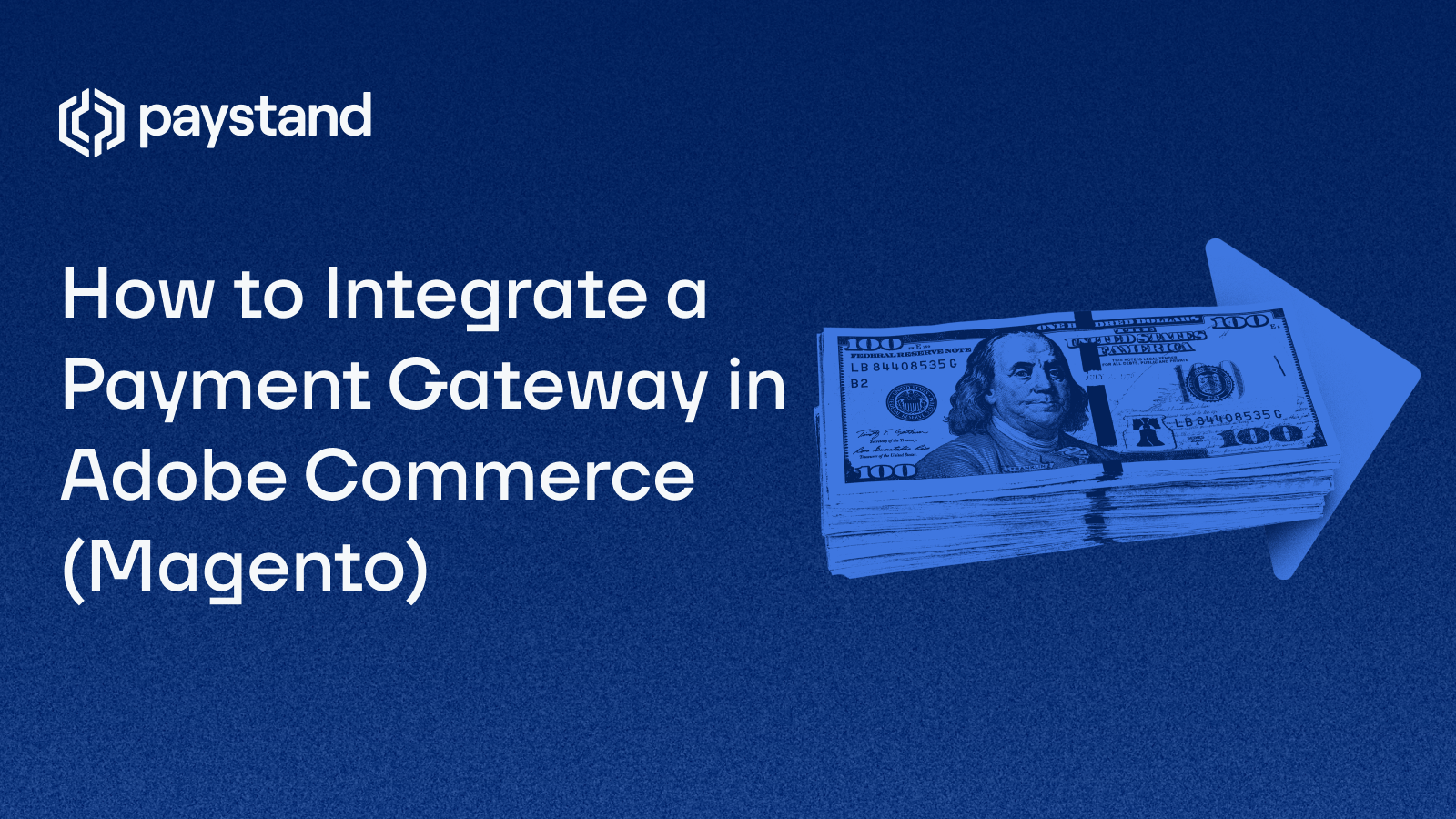How to Integrate a Payment Gateway in Adobe Commerce (Magento)

Table of Contents
- How to Choose a Payment Gateway
- What Is a Merchant Account and How to Create One
- Installing a Magento Payment Gateway Extension
- Testing Your Payment Integration
- Power Your Magento Store with Zero-Fee Payments
Key Takeaways
- Choosing the right payment gateway is essential for a seamless checkout experience and long-term scalability in Adobe Commerce (Magento).
- A merchant account is required to process and settle payments, and can be bundled with or separate from your gateway provider.
- Magento supports third-party payment gateway extensions that offer flexible payment options, branded checkout, and ERP integration.
- Testing your integration in a sandbox environment ensures secure, error-free transactions before going live.
- Paystand’s Magento extension offers embedded zero-fee bank payments, real-time ERP syncing, and customizable checkout features—designed for modern B2B transactions.
When it comes to Adobe Commerce (formerly Magento), the payment experience is critical. If your checkout isn't seamless, secure, and flexible, your buyers will bounce—and your revenue will suffer.
In this guide, we’ll walk through how to integrate a payment gateway in Magento, including how to choose the right one, what you’ll need to set it up, and how to test it properly. Whether you're just launching or looking to streamline payments across multiple storefronts, this is your roadmap.
How to Choose a Payment Gateway
Choosing the right payment gateway is about more than just accepting credit cards. Your gateway should:
- Support multiple payment options like ACH, Bank Login, credit and debit cards, and digital wallets such as Apple Pay or Google Pay
- Offer flexible checkout experiences with branded, embedded tiles that reduce redirects and improve conversions
- Minimize transaction costs with zero-fee payment options or least-cost routing
- Scale across multiple stores, currencies, and subsidiaries
- Integrate with your ERP system (if applicable) for hands-free reconciliation
If you’re operating in the B2B space, prioritize providers that offer net terms, autopay, and detailed financial reporting. For a deeper breakdown, explore our guide to choosing a payment gateway.
The Profit Paradigm Podcast
We're flipping the script on finance. No fees. No friction. Just pure cash-flow power. If you're ready to automate, accelerate, and take control of your revenue, this is where the future of money movement begins.
What Is a Merchant Account and How to Create One
Before you can process any payments, you’ll need a merchant account—a type of bank account that temporarily holds customer funds before they’re transferred to your business.
Some payment processors bundle the gateway and merchant account together. Others, like Paystand, offer more control and automation.
Here’s how it works:
- The gateway collects payment information at checkout
- That data is routed securely for approval
- Once authorized, the gateway redirects the processed payment to your merchant account
- Funds are then settled into your business bank account
You’ll typically go through an underwriting process during setup. Once approved, you’ll be able to configure your payment methods, set rules, and start accepting payments.
Installing a Magento Payment Gateway Extension
Magento (Adobe Commerce) is highly extensible—meaning you can drop in a payment gateway extension from the Marketplace and start accepting payments almost instantly.
A good extension should:
- Support ACH, Bank Login, and credit card payments
- Enable custom payment incentives like fee-sharing or discounts
- Provide a branded, embedded tile for seamless checkout
- Require minimal setup—no custom coding needed
- Support API keys for secure authentication and integration
Paystand’s Adobe Commerce extension is designed specifically for modern B2B businesses. It lets you embed zero-fee payments directly into checkout, offer net terms, and automate reconciliation with NetSuite if needed.
Testing Your Payment Integration
Once your gateway is configured, testing is a critical step before going live. Here’s how to do it right:
- Use Sandbox Mode: Most gateways offer test environments so you can simulate real transactions.
- Test All Payment Methods: Run test payments via ACH, Bank Login, credit cards, and any surcharges or discounts.
- Verify Transaction Flow: Ensure payments are posting to the correct merchant account and syncing to your order system.
- Audit for Errors: Confirm that all data is recorded correctly, receipts are generated, and customer notifications are triggered.
- Check ERP Sync (if applicable): If you’ve integrated with NetSuite or another ERP, verify that payment data is syncing correctly, down to the invoice line.
Want a step-by-step on integration testing? Our payment gateway integration checklist can help.
Power Your Magento Store with Zero-Fee Payments
Modern payment gateways should do more than process cards—they should help you optimize cash flow, reduce fees, and scale with your business.
If you're using Adobe Commerce (Magento), Paystand's extension helps you:
- Eliminate transaction fees with direct bank payments
- Keep buyers on-site with embedded, branded checkout tiles
- Configure custom incentives or fees by method or customer group
- Sync seamlessly with NetSuite using a databridge.
- Support multi-currency, and B2B pricing right out of the box
Ready to Start?
Thousands of businesses are already using Paystand to modernize B2B payments in Adobe Commerce. Slash processing costs, speed up settlement, and automate finance ops—without writing a line of code.
Learn more on our Adobe Commerce Page






%20(1)%20(1).jpg?width=100&height=100&name=IMG_3752%20(1)%20(1)%20(1).jpg)